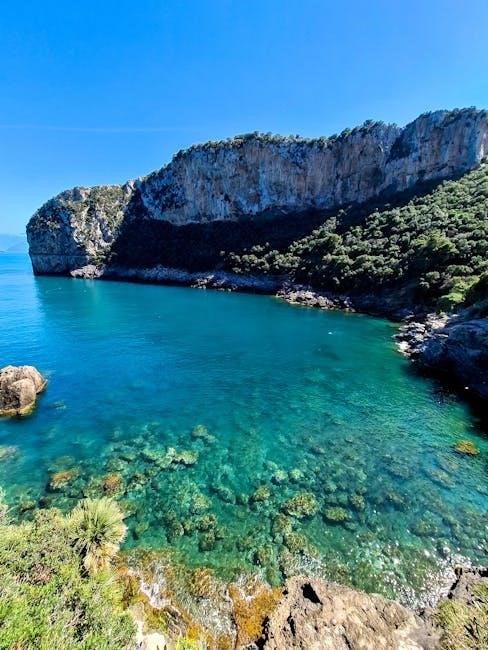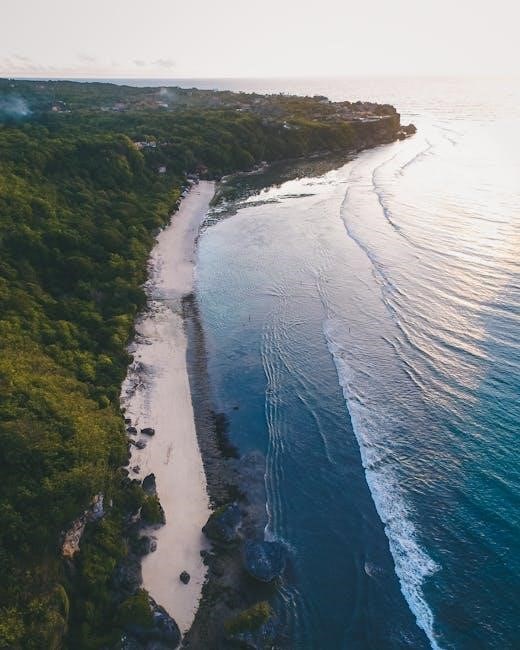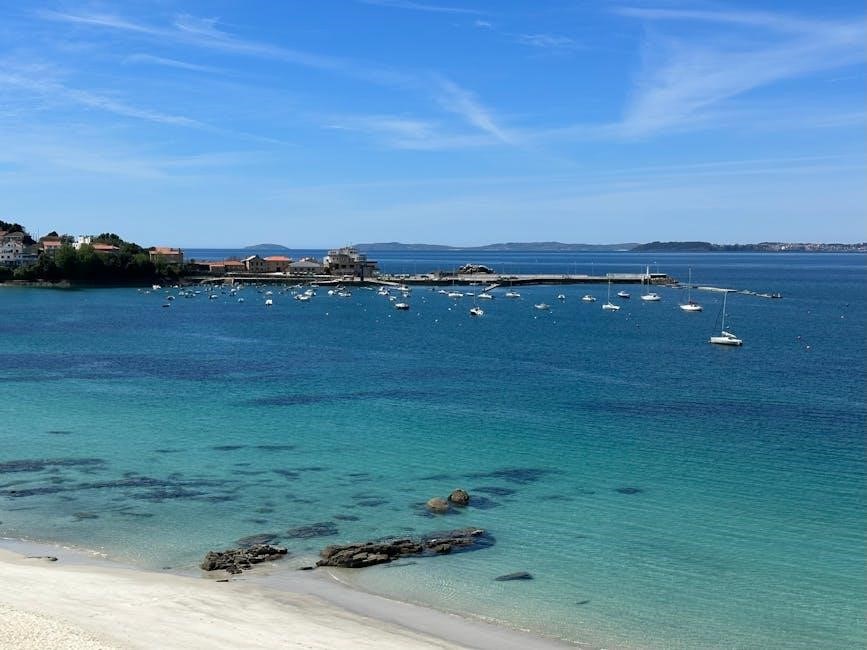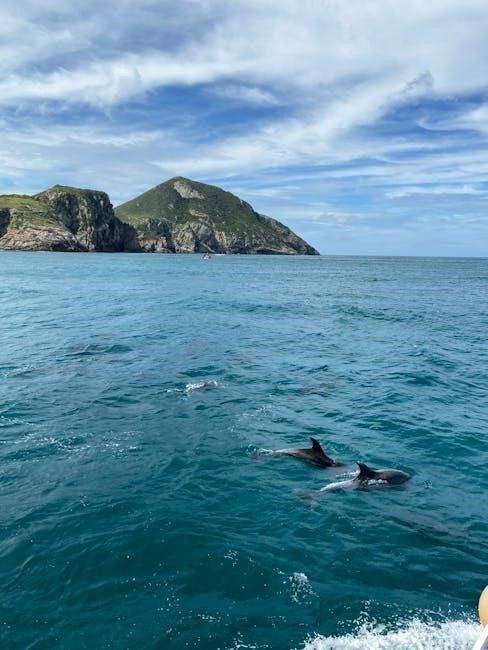“Island of the Blue Dolphins‚” a novel by Scott O’Dell‚ recounts Karana’s journey as a young Native American girl stranded on an island off 19th-century California‚ drawing inspiration from Juana Maria’s true story‚ it explores themes of survival‚ independence‚ and environmental harmony‚ making it a timeless tale of resilience and nature.
1.1 Overview of the Novel
Island of the Blue Dolphins‚ written by Scott O’Dell‚ is a captivating tale of survival and self-discovery. The story follows Karana‚ a young Native American girl‚ who finds herself stranded alone on San Nicolas Island off the coast of California in the 19th century. Inspired by the true story of Juana Maria‚ the novel explores Karana’s journey as she learns to fend for herself‚ facing challenges such as wild dogs‚ harsh weather‚ and solitude. Over time‚ she adapts to her environment‚ discovering inner strength and resourcefulness. The novel highlights themes of survival‚ independence‚ and harmony with nature‚ making it a timeless and inspiring read for audiences of all ages;
1.2 Historical Context and Inspiration
Island of the Blue Dolphins is deeply rooted in real historical events‚ drawing inspiration from the life of Juana Maria‚ a Nicoleño Native American woman who lived alone on San Nicolas Island for 18 years during the 19th century. The novel captures the essence of her resilience and adaptation‚ blending historical facts with fiction to create a compelling narrative. Scott O’Dell’s work highlights the challenges faced by Native Americans during the 1800s‚ including displacement and cultural disruption‚ while also celebrating the strength and resourcefulness of indigenous peoples. This historical backdrop adds depth and authenticity to Karana’s journey‚ making the story both educational and engaging for readers.
Historical Background of the Story
Island of the Blue Dolphins is inspired by the true story of Juana Maria‚ a Nicoleño Native American woman who lived alone on San Nicolas Island in the 1800s. This historical context highlights her 18 years of isolation‚ blending fact and fiction to create a compelling narrative of survival and resilience.
2.1 The True Story of Juana Maria
Juana Maria‚ a Nicoleño Native American‚ was inadvertently left alone on San Nicolas Island in the 19th century. She survived for 18 years‚ relying on her knowledge of nature and resourcefulness. Her story‚ marked by resilience and solitude‚ became the inspiration for Scott O’Dell’s novel. Juana Maria’s experience reflects the challenges of isolation and the deep connection to the natural world‚ themes central to “Island of the Blue Dolphins.” Her legacy endures as a testament to human endurance and adaptability in the face of adversity‚ captivating readers and historians alike with her extraordinary tale of survival and determination.
2.2 The Lone Woman of San Nicolas Island
Juana Maria‚ known as the Lone Woman of San Nicolas Island‚ lived in solitude for 18 years after being left behind during the relocation of her tribe. She survived by utilizing her knowledge of the island’s resources‚ building shelters‚ and hunting for food. Despite the isolation‚ she maintained a deep connection to her culture and the natural world. Her story‚ discovered after her rescue in 1853‚ captivated many and inspired Scott O’Dell to write “Island of the Blue Dolphins.” Juana Maria’s life on the island symbolizes resilience‚ adaptability‚ and the human spirit’s ability to thrive in the harshest conditions‚ leaving a lasting legacy in both history and literature.

Major Themes in “Island of the Blue Dolphins”
The novel explores themes of survival‚ independence‚ and environmental harmony‚ highlighting Karana’s resilience and connection to nature while emphasizing friendship‚ forgiveness‚ and self-discovery.
3.1 Survival and Independence
Karana’s journey embodies the theme of survival and independence as she navigates life on a deserted island. After being separated from her family‚ she must adapt to the harsh environment‚ facing challenges like wild dogs and scarce resources. Initially overwhelmed by fear and loneliness‚ Karana gradually learns to fend for herself‚ discovering inner strength and resourcefulness. She builds shelter‚ hunts for food‚ and creates tools‚ transforming from a scared girl into a capable woman. The novel portrays her growth as she embraces solitude‚ finding freedom in her independence and a deep connection to nature. This theme underscores the human spirit’s ability to thrive in isolation‚ highlighting resilience and self-reliance.
3.2 Friendship‚ Forgiveness‚ and Environmental Protection
Karana’s story highlights themes of friendship‚ forgiveness‚ and environmental protection. Despite her isolation‚ she forms bonds with animals like Rontu‚ a wild dog‚ and the island’s otters‚ showcasing her ability to connect with nature. Forgiveness emerges as she learns to coexist with creatures she initially feared‚ like the wild dogs responsible for her brother’s death. The novel emphasizes environmental harmony‚ as Karana respects and preserves the island’s resources‚ demonstrating a deep understanding of living sustainably. These themes reflect broader messages about empathy‚ coexistence‚ and the importance of protecting the natural world‚ making Karana’s journey a powerful allegory for modern environmentalism and human-nature relationships.
The Protagonist: Karana
Karana‚ a young Native American girl‚ embodies resilience and resourcefulness. Stranded on an island‚ she learns to survive‚ showcasing her strength and adaptability in isolation.
4.1 Karana’s Journey and Growth

Karana’s journey begins with profound loss and isolation but evolves into a testament of resilience and self-discovery. Initially overwhelmed by grief and solitude‚ she learns to adapt‚ forge tools‚ and build shelter‚ transforming from a dependent child into a capable survivor. Her growth is marked by moments of courage‚ like taming wild dogs and befriending animals‚ which showcase her ability to find companionship in isolation. Karana’s emotional maturity is evident as she learns to forgive and protect the environment‚ fostering a deep connection with nature. Her 18-year solitude shapes her into a symbol of strength‚ illustrating how adversity can lead to profound personal growth and harmony with the world around her.

The Author: Scott O’Dell
Scott O’Dell‚ born Jack Odell‚ was a renowned American author best known for his historical fiction novels‚ particularly Island of the Blue Dolphins. His work often explored themes of survival‚ nature‚ and human resilience‚ drawing inspiration from real historical events. O’Dell’s passion for storytelling and deep respect for Native American cultures are evident in his writing. Island of the Blue Dolphins‚ published in 1960‚ became his most celebrated work‚ earning him the Newbery Medal and enduring acclaim. The novel’s success lies in its ability to weave a compelling narrative around the true story of Juana Maria‚ showcasing O’Dell’s mastery of blending history with fiction. His legacy continues to inspire readers and educators‚ with the Island of the Blue Dolphins PDF remaining a valuable resource for studying his work.

The Setting: San Nicolas Island
San Nicolas Island‚ located 75 miles off the coast of Southern California‚ serves as the primary setting for Island of the Blue Dolphins. This small‚ remote island is characterized by its rugged terrain‚ harsh weather conditions‚ and abundant wildlife‚ creating a challenging yet awe-inspiring environment for Karana. The island’s isolation plays a crucial role in her survival journey‚ as she must adapt to its unforgiving climate and natural resources. The presence of wild dogs‚ sea otters‚ and other animals adds depth to the setting‚ highlighting the island’s unique ecosystem. San Nicolas Island’s historical significance as the real-life home of Juana Maria further enriches the narrative‚ blending fiction with the island’s true past. The island becomes a symbol of resilience and self-discovery in Karana’s story.

“Island of the Blue Dolphins” PDF Overview
The Island of the Blue Dolphins PDF provides a comprehensive guide to Scott O’Dell’s beloved novel. Available online‚ these resources include detailed summaries‚ thematic analyses‚ and key quotes‚ offering insights into Karana’s journey. The PDF summaries highlight the novel’s exploration of survival‚ friendship‚ and environmental protection‚ making it a valuable tool for students and educators. Additionally‚ they delve into the historical context of Juana Maria‚ the real-life inspiration for Karana. These PDFs are widely used for educational purposes‚ providing a deeper understanding of the novel’s themes and significance. They serve as an essential companion for anyone studying or teaching Island of the Blue Dolphins.
Island of the Blue Dolphins tells the story of Karana‚ a young Native American girl who lives alone on an island off the coast of California in the 1800s. After her brother Ramo’s tragic death‚ Karana must learn to survive‚ facing challenges like wild dogs‚ harsh weather‚ and solitude. The novel explores themes of survival‚ independence‚ and environmental harmony‚ as Karana adapts to her isolated life and discovers her own strength. Through her journey‚ Karana finds friendship with animals like Rontu and Tutok‚ showcasing resilience and forgiveness. The story‚ inspired by the true tale of Juana Maria‚ highlights Karana’s growth from a frightened girl to a self-reliant woman‚ making it a timeless tale of courage and nature.
Key Quotes and Their Significance
Several quotes in Island of the Blue Dolphins highlight the novel’s central themes of survival‚ resilience‚ and harmony with nature. One notable quote is Karana’s reflection: “I had not thought that the earth was so empty.” This line underscores her loneliness and isolation. Another significant quote is “We are all alike‚ and we are all different‚ and both are true आपक.” This emphasizes unity and individuality. A poignant moment is when Karana says‚ “The earth is alive‚ and I am part of it.” This reflects her deep connection to nature. These quotes encapsulate Karana’s journey of self-discovery‚ forgiveness‚ and the enduring spirit of survival‚ resonating deeply with readers of all ages.
Island of the Blue Dolphins remains a timeless tale of survival‚ resilience‚ and harmony with nature. Its enduring popularity stems from its universal themes and Karana’s inspiring journey. The novel has won the Newbery Medal and is widely studied in schools‚ highlighting its educational value. Scott O’Dell’s vivid storytelling has left a lasting impact on children’s literature‚ fostering empathy and environmental awareness. Karana’s story continues to captivate readers‚ symbolizing courage and self-discovery. The novel’s legacy lies in its ability to connect with readers across generations‚ making it a cherished classic in American literature. Its influence is evident in its adaptation into various formats‚ ensuring its message endures for years to come.
